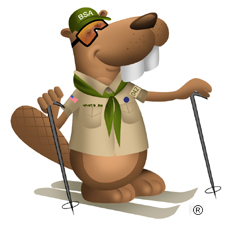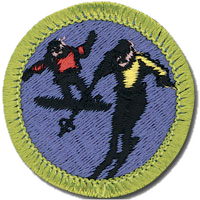Snow Sports


Resources
- Snow Sports Merit Badge Pamphlet
- Snow Sports Merit Badge Workbook
- Scoutmaster Bucky's Merit Badge Advancement Quick Reference
Snow Sports Requirements
Current Scouts BSA requirements
as of January 6, 2026
as of January 6, 2026
1.
Do the following:
a.
Explain to your counselor the hazards you are most likely to encounter
while participating in snow sport activities, and what you should do to
anticipate, help prevent, mitigate, and respond to these hazards.
b.
Discuss first aid and prevention for the types of injuries or illnesses
that could occur while participating in snow sports, including
hypothermia, frostbite, shock, dehydration, sunburn, concussion,
fractures, bruises, sprains, and strains. Tell how to apply splints.
2.
Do the following:
a.
Explain why every snow sport participant should be prepared to render
first aid in the event of an accident.
b.
Explain the procedure used to report an accident to the local ski
patrol or local emergency personnel.
3.
Explain the international trail-marking system.
4.
Discuss the importance of strength, endurance, and flexibility in snow
sports. Demonstrate exercises and activities you can do to get fit for the
option you choose in requirement 7.
5.
Present yourself properly clothed and equipped for the option you choose in
requirement 7. Discuss how the clothing you have chosen will help keep you
warm and protected.
6.
Do ALL of the following:
a.
Explain the elements of the Your Responsibility Code that is
in effect at the location whehre you will ski, snowboard, or snowshoe.
Explain why each person must follow this code.
b.
Explain the SMART Style safety program. Tell why it is important and
how it applies to participants at snow sport venues like terrain parks
and pipes.
c.
Explain the precautions pertaining to avalanche safety, including the
responsibility of individuals regarding avalanche safety.
7.
Do ONE of the following options:
Option A—Downhill (Alpine) Skiing. Do ALL of the following:
Note: Generally, a gentle slope will be a
trail designated by a green circle, a slightly steeper slope will be a
green circle or blue square trail, and an intermediate slope will be a
blue square trail. However, your counselor should determine what type of
hill is most suited to your skill level and allows you to demonstrate
each of the required skills.
1.
Show how to wax and maintain your skis and use/maintain your release
bindings. Explain the international DIN standard and what it means to
skiers.
2.
Explain the American Teaching System and a basic snowskiing
progression.
3.
Discuss the different types of Alpine skis. Demonstrate two ways to carry
skis and poles safely and easily.
4.
Demonstrate how to ride one kind of lift and explain how to ride two
others.
5.
On a gentle slope, demonstrate some of the beginning maneuvers learned
in skiing. Include the straight run, gliding wedge, wedge stop,
sidestep, and herringbone maneuvers.
6.
On slightly steeper terrain, show linked wedge turns.
7.
On a moderate slope, demonstrate five to 10 christies.
8.
Make a controlled run down an intermediate slope.
9.
Demonstrate the ability to ski in varied conditions, including
changes in pitch and snow conditions. Maintain your balance and ability
to turn.
10.
Name the major ski organizations in the United States and explain their
functions.
Option B—Cross-Country (Nordic) Skiing. Do ALL of the
following:
1.
Show your ability to select, use, and maintain equipment for
cross-country skiing in safety and comfort.
2.
Explain the reasons for common rules, including no walking on ski
trails, one-way ski direction, no pets, and no skiing on snowmobile
trails.
3.
Discuss classic, skating, touring, and telemark skis.
4.
Discuss the basic principles of waxing for cross-country ski touring.
5.
Discuss the differences between cross-country, backcountry/ski touring,
ski mountaineering, and downhill/telemark skiing.
6.
List the items you would take on a one-day ski tour.
7.
Demonstrate the proper use of a topographic map and compass.
8.
On a gentle, packed slope, show some basic ways to control speed and
direction. Include the straight run, traverse, side slip, step turn,
wedge stop, and wedge turn maneuvers.
9.
On a cross-country trail, demonstrate effective propulsion by showing
proper weight transfer form ski to ski, pole timing, rhythm, flow, and
glide.
10.
Demonstrate your ability, on a 4-mile tour, to cope with an average
variety of snow conditions.
Note: Adaptive skiers may
complete a 1-mile tour with prior approval from their counselor.
11.
Demonstrate several methods of dealing with steep hills or difficult
conditions. Include traverses and kick turns going uphill and downhill,
sidesteps, pole drag, and ski-pole "glissade."
Option C—Snowboarding. Do ALL of the following:
Note: Generally, a gentle slope will be a trail
designated by a green circle, a slightly steeper slope will be a green
circle or blue square trail, and an intermediate slope will be a blue
square trail. However, your counselor should determine what type of hill
is most suited to your skill level and allows you to demonstrate the
required skills.
1.
Discuss forward-fall injuries.
2.
Show your ability to select the correct equipment for snowboarding and
to use it for safety and comfort.
3.
Show how to use and maintain your own bindings, and explain the use of
the different binding methods. Explain the need for leashes.
4.
Discuss the four types of snowboards. Demonstrate how to carry a
snowboard easily and safely.
5.
Demonstrate how to ride one kind of lift and explain how to ride two
others.
6.
Demonstrate the basic principles of waxing a snowboard.
7.
Do the following:
a.
On a gentle slope, demonstrate beginning snowboarding maneuvers.
Show basic ways to control speed and direction. Include the
sideslipping maneuver.
b.
On slightly steeper terrain, show traversing.
8.
On a moderate slope, demonstrate an ollie, a nose-end grab, and a
wheelie.
9.
Make a controlled run down an intermediate slope.
10.
Demonstrate your ability to ride in varied conditions, including
changes in pitch, snow conditions, and moguls. Maintain your balance
and ability to turn.
11.
Name the major snowboarding organizations in the United States and
explain their functions.
Option D—Snowshoeing. Do ALL of the following:
1.
Name the parts of a snowshoe.
2.
Explain how to choose the correct size of snowshoe.
3.
Describe the different types of snowshoes and their specialized uses.
Discuss factors to consider when choosing a snowshoe.
4.
Explain how to properly care for and maintain snowshoes.
5.
List the items you would take on a one-day snowshoe hike.
6.
Describe areas that are best for snowshoeing. Discuss some advantages
and dangers of backcountry snowshoeing.
7.
Discuss the benefits of snowshoeing.
8.
Demonstrate the most efficient ways to break trail, climb uphill,
travel downhill and traverse a slope.
9.
Demonstrate your ability, on a 2-mile snowshoe hike, to cope with an
average variety of snow conditions.
Note: Adaptive
snowshoers may complete a 1-mile hike with prior approval from their
counselor.
10.
Demonstrate the proper use of a topographic map and compass.